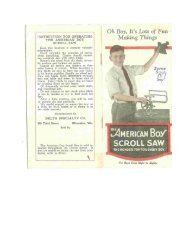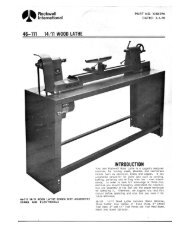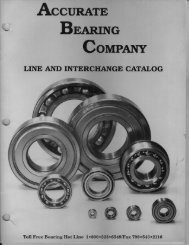Create successful ePaper yourself
Turn your PDF publications into a flip-book with our unique Google optimized e-Paper software.
ROUGHING A CYLINDER. The large gouge is used<br />
in the first turning operation of roughing-off the sharp<br />
corners of the work. Run the lathe at low speed and<br />
hold the gouge in the manner shown in Fig. 48. The<br />
cut starts about 2 inches from the tailstock end, and<br />
continues from this point towards and off the tailstock<br />
end. A second bite is ~hen taken about 2 .or 3" to the<br />
left of the first cut, advancing ~gain towards the tai 1stock<br />
to merge with the cut previous Iy made. The<br />
procedure continues unti I a point about 2" from the<br />
live center is reached where the gouge is rolled in the<br />
opposite direction to carry the final cut off the live<br />
center end of the work. The roughing cut should not<br />
be carried out with one continuous movement as this<br />
tends to tear long slivers from the corners of the work;<br />
neither should the cut be started directly at the end<br />
of the stock for the same reason. The cut can be<br />
safely carried from the center of the stock towards<br />
and off either end once the first roughing cut has been<br />
made.<br />
The position of the gouge in relation to the work involves<br />
two or three important angles. First of all,<br />
the tool may be advalJced along the work either from<br />
right to left or from left to right. From left to right<br />
or from headstock towards tailstock is preferable,<br />
since this throws the chips clear of the operator. The<br />
youge is rolled over slightly in the same direction<br />
it is advancing, as shown in Fig. 49. The tool is<br />
held well up on the work, with the bevel or grind tangent<br />
to the revolving surface, as shown in Fig. 50. In this<br />
position it will make a clean, shearing cut. When<br />
pushed straight into the work, Ii ke Fig. 51, the gouge<br />
has a scraping action, which is normally poor practice<br />
in spindle turning. The roughing cut is continued<br />
until the work approaches 1/8" of the required diameter,<br />
stepping up to second or third speed (1475 to 2220 RPM)<br />
once a barely cylindrical form has been obtained.<br />
Fig 52<br />
Fig 53<br />
15<br />
RIGHT WAY TO USE GOUGE<br />
fOR SHEARING CUT<br />
Fig 48<br />
Fig 49<br />
Fig 50 Fig 51<br />
GOUGE ''''<br />
SC.RAPING<br />
POSITION<br />
POSITION OF HANDS. In all tool handling, the handle<br />
hand takes a natural position, being nearer or further<br />
from the end of chisel depending on the amount of<br />
leverage required. The position of the tool rest hand<br />
is more a matter of individual liking rather than any<br />
set or "proper" position. However, a palm-up grip,<br />
as illustrated with the gouge, is generally considered<br />
the best practice. In this position, the first finger<br />
acts as a guide, as shown in Fig. 52, sliding along<br />
the tool rest as the cut is made. The alternate position<br />
is a palm-down grip, which is shown in Fig. 53. In<br />
this position, the heel of the hand or the little finger<br />
serves as a guide. The palm-down position is solid<br />
and positive-excellent for roughing or heavy cutting.<br />
Most beginners start with the r::alm-downgrip, switching<br />
later to the palm-up position for better manipulation<br />
of the chisel.<br />
SMOOTHING A CYLINDER. This operation is done<br />
with the large skew chisel. It demands a little practice,<br />
but should be mastered thoroughly because it is one<br />
of the most important cuts in turning. Fig. 52 and 53<br />
show how the chisel is held, using either grip as desired.<br />
The cutting point is near the center of chisel<br />
and high on tl:le work, as shown in Fig. 54. The chisel<br />
must be supported. by the tool rest at all times - in<br />
striving for a certain position in relation to the work,<br />
the beginner often overlooks this all-important point.<br />
Beginners often use the method shown in Fig. 54 to<br />
locate the proper tool position. To do this, you place<br />
the skew well over the work and riding. flat against it.








